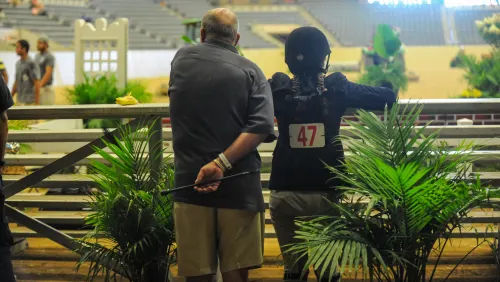Fred* (name changed to protect the large and fuzzy) is a curious case. Backed as a 3-year-old in draw reins and a chambon attached to less than ideal hands, he started sticking his tongue out. He’s now in his mid-teens, and he’s been doing it ever since.
Fred’s not helped by nature—he’s a funny cross, one of the ones you’d be surprised to learn wasn’t an accident, and he has a long back, a short, thick neck and a flighty temperament. But nurture has not done all it could to improve his shortcomings.
Fred and his owner came to me with very realistic goals—I didn’t need to fix the problem, but it would be nice if I could. I always go the veterinary route first when I’m hitting a wall—Lyme, EPM, teeth. All normal. The saddle fit was a mess, so we got him in well-fitting tack and started a regimen of regular chiropractic and acupuncture care. His fitness improved. His back got stronger. And the tongue improved a little, though admittedly not a lot.
Next stop: musical equipment. We played with different bits. He was going in a single jointed snaffle with a funny bend to it, like a port. So I tried a single jointed snaffle with no bend; no joy. My old standby, a KK? Nope. French link, boucher, eggbutt, loose ring. Nothing made a difference until the owner suggested a Mylar D-ring. It helped some, and then I had the brainstorm of wrapping it in latex. Bingo! A big improvement. Still not fixed, though, so it was onto round two: nosebands.
He was in a drop, but a very flat drop, no padding, with no cushion over the poll either. I put him in an Albion bridle with lots of padding over the poll, plus a cutback for his (rather large) ears. This made a big difference right away, so I knew we were on the right track. A traditional noseband, with a flash, made the biggest difference of all, but it made Fred VERY strong, so I put him back in a drop with lots of squish.
And that, for the last few months, is where we’ve been. Fred has really improved, but that tongue makes a guest appearance every ride, at least a few times. So my last hope came in an experiment—the Micklem Multibridle, lent to me by a wonderful stranger I found on one of the dressage bulletin boards. Thanks, Carol!
ADVERTISEMENT
The Micklem bridle is five headstalls in one—halter, longing cavesson, bridle and two bitless variations. It looks a little like a funky figure-8, designed to stabilize the bit without putting pressure on the sensitive nerves of the face.
It’s a great idea, but for Fred, it wasn’t the solution. I tried it first with the bit, and the tongue was a’flyin almost immediately. Not helpful. So I took the bit off and spent the rest of the ride in the “mild” bitless configuration. To me, with exactly zero expertise in bitless riding, it looked like a closely-fitting halter with reins on it, and it worked about as well. Fred was controllable, but there was no finesse, no precision work. He was not “round,” and he was also quite strong. To top it all off, he stuck his tongue out, even without a bit! Clearly not the solution.
The next ride, I tried it in its “moderate” form, which uses an attachment to make the bridle work like a sidepull. I had more control, but not over the things I wanted—Fred turned and stopped with no issues, but was anything but round, and he was even stronger than the day before. No tongue, but greatly reduced rideability. I had his owner try it on him, just for giggles, and she felt the same way.
Fred learned that sticking his tongue out was a way of escaping the bit, and no one corrected the problem while it was still fresh. I fear that ship has sailed, and there’s probably no tool I could go to that would fix it—it’s a part of him now, a part that makes a show career impossible. But every horse can be improved with the right tools, and while the Micklem didn’t help him, I’ll keep it in mind for the next funky horse that comes my way.
As a professional rider, people rarely bring you the uncomplicated, straightforward horses for you to ride—they’re usually complicated, and the solution is rarely easy.















